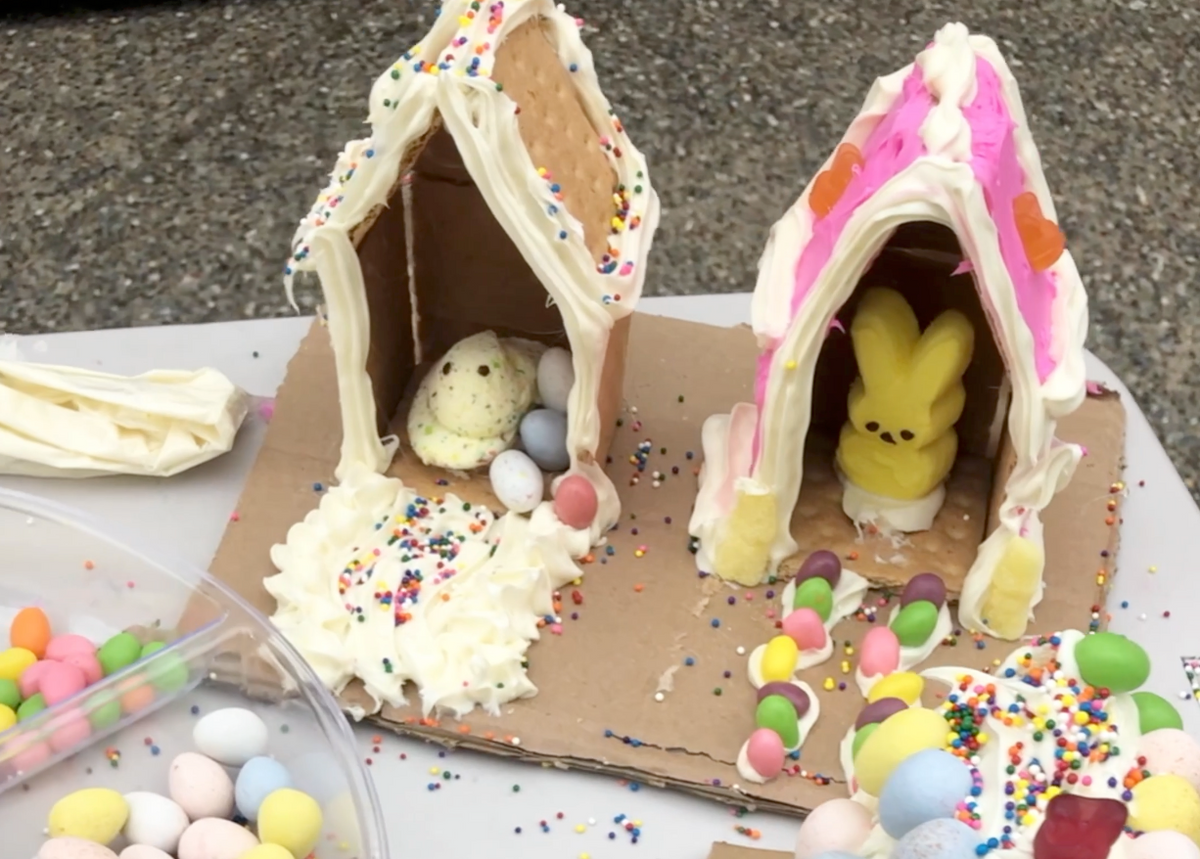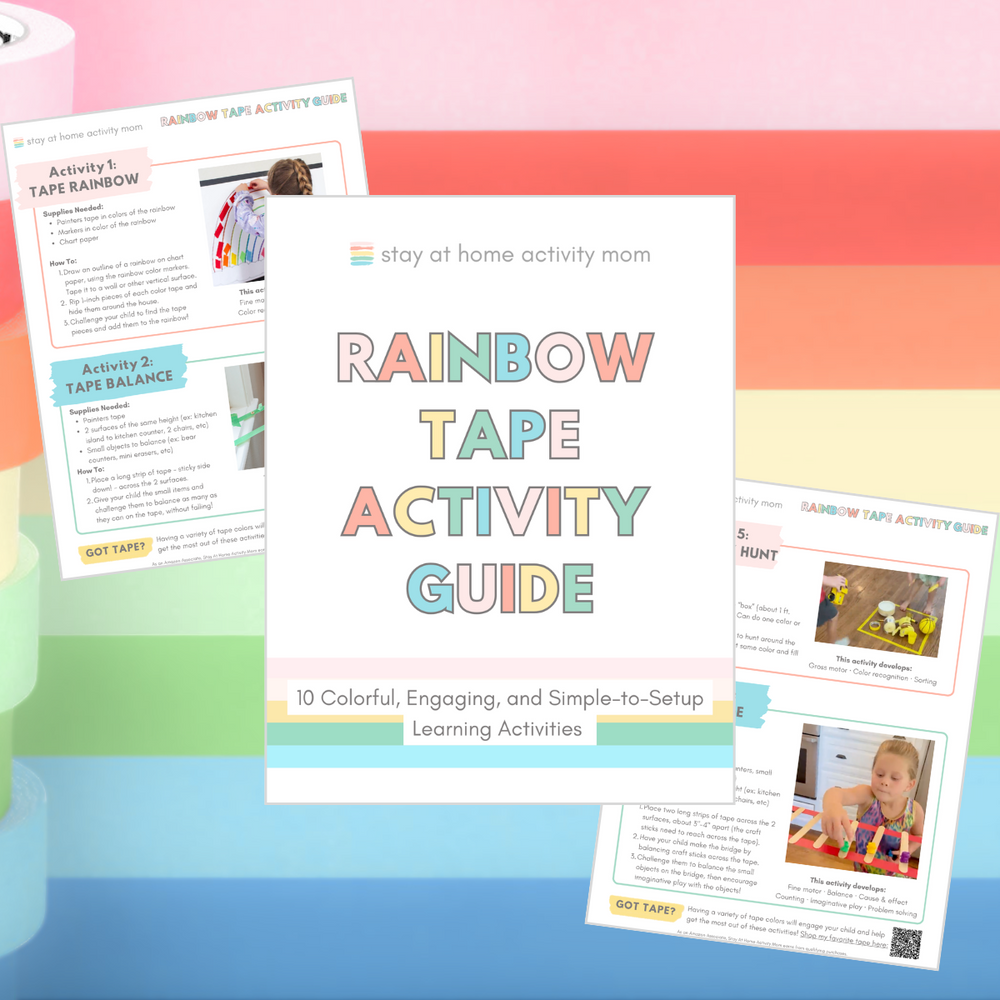

Are you looking for a fun Easter activity for kids that combines creativity, snacking, and minimal prep work? Easter Peep houses are the perfect "snacktivity" that will keep little hands busy and result in adorable spring festivities! As a mom of three and former educator, I've tested countless holiday activities, and these sweet little houses have become our family's favorite Easter tradition.
What is a Snacktivity?!
A "snacktivity" is a genius combination of snack and activity – it's a fun project that kids can create and snack on during the process!
My Easter Peep house snacktivity is the springtime version of gingerbread houses, designed specifically to feature these signature Easter marshmallow treats! Using simple materials like graham crackers and frosting, your children can build adorable little homes for their Peeps that double as festive decorations and delicious treats.
What makes this Easter activity for kids so special is the perfect balance of simplicity, creativity, and seasonality! Plus, since it's a SNACKtivity, it's a multi-sensory experience!
Benefits of This Easter Activity for Kids
As both a mom and educator, I'm always looking for activities that combine learning with fun. Easter Peep houses deliver multiple benefits in one simple package:
- Fine Motor Development: Applying frosting, placing small candies, and carefully assembling the crackers provides excellent fine motor practice for little hands.
- Creative Expression: Each child can design their house exactly how they want, encouraging artistic decision-making.
- Following Instructions: Building the basic structure teaches kids to follow simple step-by-step directions.
- Math Concepts: Discuss shapes, symmetry, and patterns as you build.
- Sensory Experience: Different textures, materials, and flavors make this an excellent sensory activity!
- Practical Life Skills: Measuring, assembly, patience, and careful handling are all at work as your child builds and creates their Easter peep house.
- Easter Egg Hunt Extension: Children can use candy collected from their Easter egg hunt to decorate their houses, creating a perfect post-hunt activity!
Plus, this Easter activity for kids is adaptable across ages - toddlers can focus on decorating while older children can handle the more complex construction aspects. It's also a wonderful way to use up extra Easter candy in a creative way rather than having it all consumed at once!
Materials You'll Need for Easter Peep Houses
Basic Supplies:
- Graham crackers (6 halves per house)
- Thick frosting (the kind that hardens when dry)
- Peeps marshmallow bunnies or chicks
- Small Easter candies (jelly beans, M&Ms, pastel-colored chocolates)
- Frosting for attaching the easter candies to the house (canister frosting works well for this!)
- Paper plates or cardboard squares for bases
- Plastic knives or popsicle sticks for spreading frosting
Optional Extras for This Easter Activity for Kids:
- Edible Easter grass (found in seasonal candy aisles) or green-tinted shredded coconut (make ahead of time!)
- Decorative sprinkles
- Low-temperature hot glue gun (IMPORTANT: If using hot glue to assemble the houses, they become NON-EDIBLE decorations only! Always clearly mark and separate any hot-glued houses from edible ones)
Mom Tip: If you're working with toddlers, pre-assemble the basic structure and let them focus on the decorating part. For early elementary children, guide them through the building process as a learning opportunity.

Step-by-Step Guide to Building Easter Peep Houses
Preparation (5 minutes)
- Gather all materials. I like to use a muffin tin or divided tray for all the different decorating materials!
- Separate graham crackers into halves along perforations (you'll need 5-6 halves per house).
Building the Foundation (10 minutes)
- Place one graham cracker half flat on your plate or cardboard - this is the floor
- Apply a thick line of frosting along three edges of the floor piece
- Stand three graham cracker halves vertically into the frosting to create three walls, leaving one side open
- Hold each piece in place for 30-45 seconds until it begins to set
- Apply additional frosting at the corners where walls meet for extra stability
Adding the Roof (5 minutes)
- Once walls are stable, apply frosting along the top edges of your walls
- Place two graham cracker halves at an angle to form a triangular roof
- Add more frosting at the peak where the roof pieces meet
- Allow the structure to dry for 10-15 minutes before decorating
Mom Tip: The drying step is essential for this Easter activity for kids! Rushing to decorate before the structure is stable is the number one cause of collapsed houses and sad kiddos!
Decorating Your Easter Peep Houses (15+ minutes)
- Once the basic structure is stable, let creativity flow!
- Add "grass" inside and around the house using green coconut or edible Easter grass.
- Place Peeps inside the house (through the open wall)
- Use additional frosting as "glue" to attach candies to the outside of the house
- Add decorative details like frosting "windows" or candy pathways
The hot glue alternative: If you're making these purely for display (not eating), a low-temperature hot glue gun can assemble the structures instantly. Just supervise closely with children! IMPORTANT: Houses assembled with hot glue are NOT EDIBLE. Always clearly mark and separate any hot-glued houses from edible ones, and make sure children understand which houses cannot be eaten.

Easter Peep Houses Learning Opportunities & Prompts
To make the most of these fine motor activities with your little ones:
- Model first : Show your child how to do each activity before expecting them to try independently.
- Start simple : Begin with fewer cups and simpler configurations, then add complexity as skills develop.
- Be patient : Some children may need multiple attempts before mastering certain movements.
- Celebrate effort : Praise persistence and attempts, not just successful completion.
- Ask questions : Encourage thinking with questions like "What might happen if...?" or "How else could we...?"
- Follow their lead : If your child discovers a new way to play with the cups, go with it!
- Make it routine : Incorporate fine motor activities into your weekly play rotation for skill reinforcement.
The beauty of these fine motor activities for toddlers is their versatility. As your child grows, you can adjust the difficulty level to continue challenging their developing skills. Plus, plastic cups are inexpensive, easily stored, and remarkably durable for repeated play sessions!
Tips for Easter Peep House Success
As an educator, I love how this simple Easter activity for kids can be expanded into learning moments. Check out examples of verbal prompts you can use during the building process!
-
Vocabulary building: Discuss architectural terms like foundation, structure, support, and design.
- "Look at how sturdy your house's foundation is! The foundation is the base that holds everything up."
- "Let's make sure the structure is balanced so it doesn't tip over."
- "What design are you creating on your roof?"
-
Color recognition: Sort candies by color before decorating.
- "Can you sort these candies by color before we start decorating?"
- "Which color jelly beans would look best for the flower garden?"
- "Let's count how many different colors we've used in our house."
-
Counting practice: Count pieces needed or candies used.
- "How many graham crackers do we need for one house?"
- "Let's count how many Peeps can fit inside your house!"
- "If each person gets 10 candies to decorate with, how many will we need altogether?"
-
Problem-solving: As challenges arise during the process, talk through the issue together and ask them for their solution ideas.
- "Oh no, the roof keeps sliding off! What could we try to make it stay in place?"
- "The walls are wobbling—what could we add to make them more stable?"
- "How can we make a door that opens and closes?"
-
Storytelling: Encourage children to create stories about the Peeps who live in their houses.
- "Who do you think lives in this Peep house?"
- "What do you think the Peep bunny does during the day?"
- "Can you tell me a story about why your Peep chose to decorate their house this way?"
-
Science concepts: Talk about why the frosting hardens and how it works as "cement."
- "Watch how the frosting works like cement—it starts soft but gets hard and holds things together."
- "Why do you think the frosting hardens?"
- "What happens if we add too much water to our coconut grass?"
Remember to follow your child's lead and keep the conversation natural and fun. The goal isn't to turn this into a formal lesson but to enhance the natural learning that happens during creative play!
Creative Variations to Make This Easter Activity for Kids Even More Fun
After making dozens of Peep houses with my own children and in classroom settings, I've seen some wonderfully creative variations that keep this Easter activity fresh and exciting:
1. Peep Chicken Coops
Use the yellow chick Peeps and design the house to look like a chicken coop. Create a tiny nesting area with candy eggs.
2. Peep Condos
Build a two-story structure by creating a second floor using an additional graham cracker and small graham cracker "stairs." Perfect for siblings who want their Peeps to live near each other!
3. Peep Garden Cottages
Create a garden around your Peep house using different colored candies as "flowers" and green frosting for "vines" climbing up the sides of the house.
4. Peep Mansions
For older children with more patience, try connecting multiple graham cracker structures to create a larger, more complex Peep mansion with several rooms.
How to Incorporate Fine Motor Activities Into Your Daily Routine
Finding time for dedicated play activities can be challenging for busy parents. The good news is that fine motor activities for toddlers don't need to be separate events in your day. Consider these ways to naturally incorporate them:
- Morning routine : Set up a quick cup stacking game while prepping breakfast
- Transition times : Use the cup hunt as a transition activity between other tasks
- After meal cleanup : Turn cleaning up cups or plates into a stacking challenge
- Bathtime : Bring plastic cups into the tub for pouring and water play
- Outdoor play : Take the cup target toss outside on nice days for gross motor practice
Even just 10-15 minutes of focused fine motor practice each day can make a significant difference in your child's development. The key is consistency rather than marathon play sessions.
Easter Activity for Kids: Creating Traditions That Last
What I love most about Easter Peep houses is how they've become a favorite tradition in our family. Every Spring, my kids ask when we'll be making our Peep houses, and we've watched their creations grow more complex and creative each year!
These simple little houses made of graham crackers and Easter candy create the kind of childhood memories that last a lifetime - the sticky fingers, the concentrated expressions as they carefully place each candy, and the proud smiles when they show off their completed creations. Plus...even I love the excuse to snack on delicious Easter candy!
I hope this Easter activity for kids brings as much joy to your family as it has to mine!
Disclaimer: This post may contain affiliate links. If you purchase through these links, I may earn a small commission at no additional cost to you. All recommendations are based on items I personally use and love with my own children.






